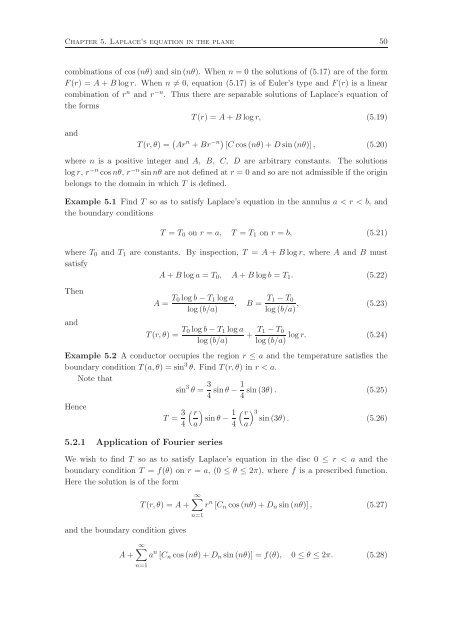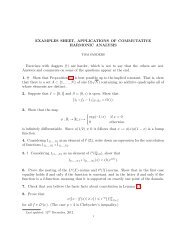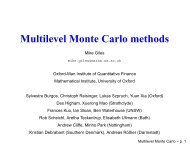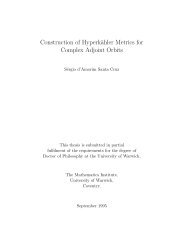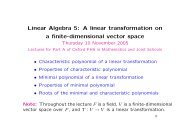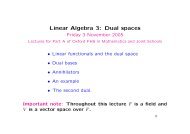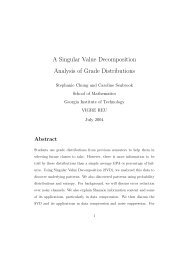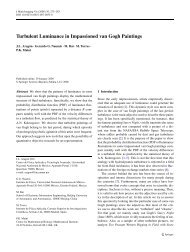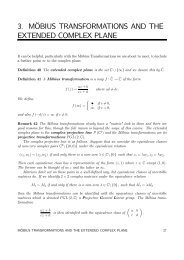Fourier Series and Partial Differential Equations Lecture Notes
Fourier Series and Partial Differential Equations Lecture Notes
Fourier Series and Partial Differential Equations Lecture Notes
You also want an ePaper? Increase the reach of your titles
YUMPU automatically turns print PDFs into web optimized ePapers that Google loves.
Chapter 5. Laplace’s equation in the plane 50<br />
combinations of cos(nθ) <strong>and</strong> sin(nθ). When n = 0 the solutions of (5.17) are of the form<br />
F(r) = A +Blogr. When n = 0, equation (5.17) is of Euler’s type <strong>and</strong> F(r) is a linear<br />
combination of r n <strong>and</strong> r −n . Thus there are separable solutions of Laplace’s equation of<br />
the forms<br />
T(r) = A+Blogr, (5.19)<br />
<strong>and</strong><br />
T(r,θ) = Ar n +Br −n [Ccos(nθ)+Dsin(nθ)], (5.20)<br />
where n is a positive integer <strong>and</strong> A, B, C, D are arbitrary constants. The solutions<br />
logr, r −n cosnθ, r −n sinnθ are not defined at r = 0 <strong>and</strong> so are not admissible if the origin<br />
belongs to the domain in which T is defined.<br />
Example 5.1 Find T so as to satisfy Laplace’s equation in the annulus a < r < b, <strong>and</strong><br />
the boundary conditions<br />
T = T0 on r = a, T = T1 on r = b, (5.21)<br />
where T0 <strong>and</strong> T1 are constants. By inspection, T = A + Blogr, where A <strong>and</strong> B must<br />
satisfy<br />
A+Bloga = T0, A+Blogb = T1. (5.22)<br />
Then<br />
<strong>and</strong><br />
A = T0logb−T1loga<br />
, B =<br />
log(b/a)<br />
T1 −T0<br />
, (5.23)<br />
log(b/a)<br />
T(r,θ) = T0logb−T1loga<br />
log(b/a)<br />
+ T1 −T0<br />
logr. (5.24)<br />
log(b/a)<br />
Example 5.2 A conductor occupies the region r ≤ a <strong>and</strong> the temperature satisfies the<br />
boundary condition T(a,θ) = sin 3 θ. Find T(r,θ) in r < a.<br />
Hence<br />
Note that<br />
T = 3<br />
4<br />
sin 3 θ = 3 1<br />
sinθ− sin(3θ). (5.25)<br />
4 4<br />
<br />
r<br />
<br />
sinθ−<br />
a<br />
1<br />
4<br />
5.2.1 Application of <strong>Fourier</strong> series<br />
<br />
r<br />
3 sin(3θ). (5.26)<br />
a<br />
We wish to find T so as to satisfy Laplace’s equation in the disc 0 ≤ r < a <strong>and</strong> the<br />
boundary condition T = f(θ) on r = a, (0 ≤ θ ≤ 2π), where f is a prescribed function.<br />
Here the solution is of the form<br />
T(r,θ) = A+<br />
<strong>and</strong> the boundary condition gives<br />
A+<br />
∞<br />
r n [Cncos(nθ)+Dnsin(nθ)], (5.27)<br />
n=1<br />
∞<br />
a n [Cncos(nθ)+Dnsin(nθ)] = f(θ), 0 ≤ θ ≤ 2π. (5.28)<br />
n=1


